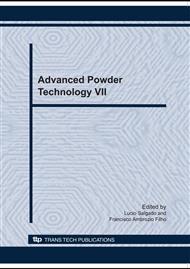[1]
R. R. Menezes et al. : Revista Matéria Vol. 12 (1) (2007), pp.226-236.
Google Scholar
[2]
M. I. Brasileiro et. al.: Materials Science Forum Vols. 530-531 (2006), pp.625-630.
Google Scholar
[3]
M. S. Barata and D. C. C. Dal Molin: Associação Nacional de Tecnologia do Ambiente Construído, Vol. 2 (1) (2002), p.669.
Google Scholar
[4]
M.I. Brasileiro et. al.: Materials Science Forum Vols. 591-593 (2008), p.799.
Google Scholar
[5]
L. N. L. Santana et. al.: Influência das matérias-primas em corpos cerâmicos contendo resíduo de caulim. 51° Congresso Brasileiro de Cerâmica. 2007. Proceeding… pp.1-12.
DOI: 10.1590/s0366-69132005000300010
Google Scholar
[6]
H. Shneider, J. Schreuer and B. Hildmann: J. Eur. Ceram. Soc. Vol. 28 (2008), p.329.
Google Scholar
[7]
H. Shneider and S. Komanerni: Mullite (Federal Republic of Germany, 2005).
Google Scholar
[8]
S.C. Vieira, Ramos and M.T. Vieira: Vol. 33 (2007), p.59.
Google Scholar
[9]
R.R. Monteiro, A.C.S. Sabioni and G.M. da Costa: Cerâmica Vol. 50 (2004), p.318.
Google Scholar
[10]
M. Panneerselvam and K.J. Rao: Chem. Mater Vol. 15 (2003), p.2247.
Google Scholar
[11]
Z. Xie, J. Yang, X. Huang and Y. HUANG: Journal of European Ceramic Society Vol. 19 (1999), p.381.
Google Scholar
[12]
W.H. Sutton: Am. Ceram. Soc. Bull. Vol. 68 (1989), p.376.
Google Scholar
[13]
S.S. Park, K.S. Jung, B.W. Kim, S.E. Lee and H.C. Park: Glass Tech. Vol. 43 (2002), p.70.
Google Scholar
[14]
R. R. Menezes, P.M. Souto and R.H.G.A. Kiminami: Cerâmica Vol. 53 (2007), p.1.
Google Scholar
[15]
M.S. Spotz, D.J. Skamser and D.L. Johnson: Journal American Ceramic Society Vol. 78 (1995), p.1041.
Google Scholar
[16]
G. Roussy, A. Bennani and J.M. Thiebaut: Journal Apllied Physics Vol. 62 (1987), p.1167.
Google Scholar
[17]
A. Dé, I. Ahmad, D. Whitney and D.E. Clark: American Ceramic Society Vol. 21 (1991), p.319.
Google Scholar
[18]
M.A. Janney, C.L. Calhon and H.D. Kimrey: Journal American Ceramic Society Vol. 75 (2) (1992), p.341.
Google Scholar
[19]
A. Dé, I. Ahmad, D. Whitney and D.E. Clark: American Ceramic Society Vol. 21 (1991), p.329.
Google Scholar
[20]
R. R. Menezes, P.M. Souto and R.H.G.A. Kiminami: Cerâmica Vol. 53 (2007), p.218.
Google Scholar
[21]
F. Sahnoune, M. Chegaar, N. Saeb, P. Goeuriot and F. Valdivieso: Applied Clay Science Vol. 38 (2008), p.304.
DOI: 10.1016/j.clay.2007.04.013
Google Scholar
[22]
K.C. Liu and G. Thomas: J. Am. Ceram. Soc. Vol. 77 (6) (1994), p.1545.
Google Scholar


